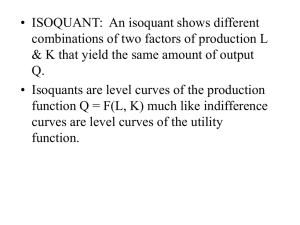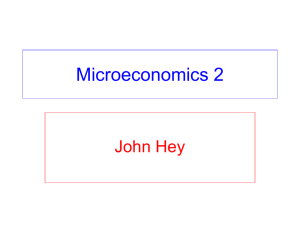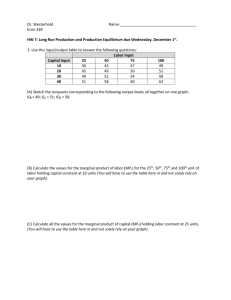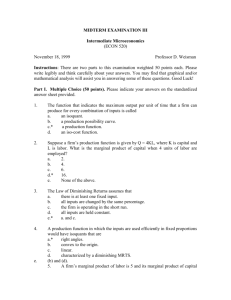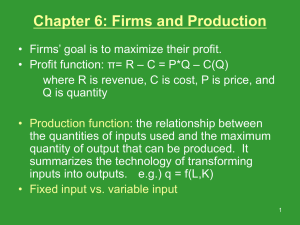Production
advertisement
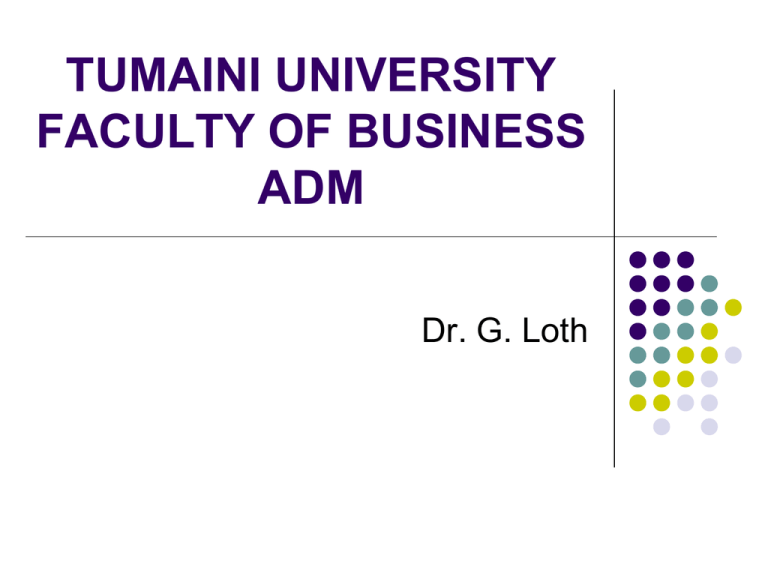
TUMAINI UNIVERSITY FACULTY OF BUSINESS ADM Dr. G. Loth Production: Introduction Definition Production is the process of transforming inputs in to outputs inputs are also known as factors of production Outputs are goods and services Production: Introduction A firm is a unit that takes decision with respect to production and sale of goods and services. Eg. Proprietorship – owner managed - small scale - small capital Production: Introduction partnership – owned by a group of partners up to 10, - joint management - unlimited liability - every partner is responsible for all debts of the firm limited company – owned by association of individuals - main objective is profit making - shareholders are proprietors of the company Production: Introduction - the liability of a shareholder is limited to the face value of the share - can be public or private - in public companies shares are transferable cooperatives – form of bus. Organization where people come together for business purpose on the basis Production: Introduction - members of the cooperative work for it, own it and share profits - they are democratically organized…equality and free association e.g. credit and consumer societies. Production: Factors of production Input – anything that the firm uses in its production process. Fixed input – its quantity cannot be changed during the period of time under consideration e.g. plant and equipment Variable input – its quantity can be changed during the period under consideration e.g. labour. Production: Factors of production Both fixed and variable inputs are generally classified into four groups: 1. Land – fixed, gift of nature varies in quality 2. Labour – human effort/work done by human beings, skilled and unskilled 3. Capital – man made wealth, r/materials, machinery, buildings, factories, tools etc. Production: Factors of production Entrepreneurship - managerial ability of the firm - involves the use of initiatives, skills, risk taking in decision making. Topics to be Discussed The Technology of Production Isoquants Production with One Variable Input (Labor) Production with Two Variable Inputs Returns to Scale Introduction Our focus is the supply side. The theory of the firm will address: How a firm makes cost-minimizing production decisions How cost varies with output Characteristics of market supply Issues of business regulation The Technology of Production The Production Process Combining inputs or factors of production to achieve an output Categories of Inputs (factors of production) Labor Materials Capital The Technology of Production Production Function: Indicates the highest output that a firm can produce for every specified combination of inputs given the state of technology. Shows what is technically feasible when the firm operates efficiently. Production with One Variable Input (Labor) Amount of Labor (L) Amount Total of Capital (K) Output (Q) Average Product Marginal Product 0 10 0 --- --- 1 10 10 10 10 2 10 30 15 20 3 10 60 20 30 4 10 80 20 20 5 10 95 19 15 6 10 108 18 13 7 10 112 16 4 8 10 112 14 0 9 10 108 12 -4 10 10 100 10 -8 Production with One Variable Input (Labor) Observations: 1) With additional workers, output (Q) increases, reaches a maximum, and then decreases. Production with One Variable Input (Labor) Observations: 2) The average product of labor (AP), or output per worker, increases and then decreases. Output Q AP Labor Input L Production with One Variable Input (Labor) Observations: 3) The marginal product of labor (MP), output of the additional worker, increases rapidly initially and then decreases and becomes negative.. Output Q MP L Labor Input L or Production with One Variable Input (Labor) Output per Month D 112 Total Product C 60 A: slope of tangent = MP (20) B: slope of OB = AP (20) C: slope of OC= MP & AP B A 0 1 2 3 4 5 6 7 8 9 10 Labor per Month Production with One Variable Input (Labor) Outpu t per Month Observations: Left of E: MP > AP & AP is increasing Right of E: MP < AP & AP is decreasing E: MP = AP & AP is at its maximum 30 Marginal Product E 20 Average Product 10 0 1 2 3 4 5 6 7 8 9 10 Labor per Month Production with One Variable Input (Labor) Observations: When MP = 0, TP is at its maximum When MP > AP, AP is increasing When MP < AP, AP is decreasing When MP = AP, AP is at its maximum Production with One Variable Input (Labor) AP = slope of line from origin to a point on TP, lines b, & c. MP = slope of a tangent to any point on the TP line, lines a & c. Output per Month 112 D Output per Month 30 C E 60 20 B 10 A 0 1 2 3 4 5 6 7 8 9 10 Labor per Month Labor 0 1 2 3 4 5 6 7 8 9 10 per Month Production with One Variable Input (Labor) The Law of Diminishing Marginal Returns As the use of an input increases in equal increments, a point will be reached at which the resulting additions to output decreases (i.e. MP declines). Production with One Variable Input (Labor) The Law of Diminishing Marginal Returns As the use of an input increases in equal increments, a point will be reached at which the resulting additions to Total output decreases (i.e. MP declines). Production with One Variable Input (Labor) The Law of Diminishing Marginal Returns When the labor input is small, MP increases due to specialization. When the labor input is large, MP decreases due to inefficiencies. Production with One Variable Input (Labor) The Law of Diminishing Marginal Returns Can be used for long-run decisions to evaluate the trade-offs of different plant configurations Assumes the quality of the variable input is constant Production with One Variable Input (Labor) The Law of Diminishing Marginal Returns Explains a declining MP, not necessarily a negative one Assumes a constant technology The Effect of Technological Improvement Output per time period Labor productivity can increase if there are improvements in technology, even though any given production process exhibits diminishing returns to labor. C 100 B O3 A O2 50 O1 0 1 2 3 4 5 6 7 8 9 10 Labor per time period Malthus and the Food Crisis Malthus predicted mass hunger and starvation as diminishing returns limited agricultural output and the population continued to grow. Why did Malthus’ prediction fail? Index of World Food Consumption Per Capita Year Index 1948-1952 1960 1970 100 115 123 1980 1990 128 137 1995 135 1998 140 Malthus and the Food Crisis The data show that population growth production increases have exceeded. Malthus did not take into consideration the potential impact of technology which has allowed the supply of food to grow faster than demand. Malthus and the Food Crisis Technology has created surpluses and driven the price down. Question If food surpluses exist, why is there hunger? Malthus and the Food Crisis Answer The cost of distributing food from productive regions to unproductive regions and the low income levels of the non-productive regions. Production with One Variable Input (Labor) Labor Productivity Total Output Average Productivi ty Total Labor Input Production with One Variable Input (Labor) Labor Productivity and the Standard of Living Consumption can increase only if productivity increases. Determinants of Productivity Stock of capital Technological change Labor Productivity in Developed Countries France Germany Japan United Kingdom United States Output per Employed Person (1997) $54,507 $55,644 $46,048 $42,630 $60,915 Annual Rate of Growth of Labor Productivity (%) 1960-1973 1974-1986 1987-1997 4.75 2.10 1.48 4.04 1.85 2.00 8.30 2.50 1.94 2.89 1.69 1.02 2.36 0.71 1.09 The Technology of Production The production function for two inputs: Q = F(K,L) Q = Output, K = Capital, L = Labor For a given technology The production function for two inputs Assumptions Food producer has two inputs Labor (L) & Capital (K) Production Function for Food Labor Input Capital Input 1 2 3 4 5 1 20 40 55 65 75 2 40 60 75 85 90 3 55 75 90 100 105 4 65 85 100 110 115 5 75 90 105 115 120 Production with Two Variable Inputs (L,K) Capital per year The Isoquant Map E 5 4 3 A B The isoquants are derived from the production function for output of of 55, 75, and 90. C 2 Q3 = 90 D 1 Q2 = 75 Q1 = 55 1 2 3 4 5 Labor per year Isoquants Isoquants Curves showing all possible combinations of inputs that yield the same output Isoquants Observations: 1) For any level of K, output increases more L. with 2) For any level of L, output increases more K. with 3) Various combinations of inputs produce the same output. Isoquants Input Flexibility The isoquants emphasize how different input combinations can be used to produce the same output. This information allows the producer to respond efficiently to changes in the markets for inputs. The Short Run versus the Long Run Short-run: Period of time in which quantities of one or more production factors cannot be changed. These inputs are called fixed inputs. Isoquants The Short Run versus the Long Run Long-run Amount of time needed to make all production inputs variable. Production with Two Variable Inputs There is a relationship between production and productivity. Long-run production K& L are variable. Isoquants analyze and compare the different combinations of K & L and output The Shape of Isoquants Capital per year E 5 4 3 A B In the long run both labor and capital are variable and both experience diminishing returns. C 2 Q3 = 90 D 1 Q2 = 75 Q1 = 55 1 2 3 4 5 Labor per year Production with Two Variable Inputs Diminishing Marginal Rate of Substitution Reading the Isoquant Model 1) Assume capital is 3 and labor increases from 0 to 1 to 2 to 3. Notice output increases at a decreasing rate (55, 20, 15) illustrating diminishing returns from labor in the short-run and long-run. Production with Two Variable Inputs Diminishing Marginal Rate of Substitution Reading the Isoquant Model 2) Assume labor is 3 and capital increases from 0 to 1 to 2 to 3. Output also increases at a decreasing rate (55, 20, 15) due to diminishing returns from capital. Production with Two Variable Inputs Substituting Among Inputs Managers want to determine what combination of inputs to use. They must deal with the trade-off between inputs. Production with Two Variable Inputs Substituting Among Inputs The slope of each isoquant gives the trade-off between two inputs while keeping output constant. Marginal Rate of Technical Substitution Capital per year 5 4 Isoquants are downward sloping and convex like indifference curves. 2 1 3 1 1 2 2/3 Q3 =90 1 1/3 1 Q2 =75 1 Q1 =55 1 2 3 4 5 Labor per month Production with Two Variable Inputs Substituting Among Inputs The marginal rate of technical substitution equals: MRTS - Change in capital/Ch ange in labor input MRTS K L (for a fixed level of Q) Marginal Rate of Technical Substitution Capital per year 5 4 Isoquants are downward sloping and convex like indifference curves. 2 1 3 1 1 2 2/3 Q3 =90 1 1/3 1 Q2 =75 1 Q1 =55 1 2 3 4 5 Labor per month Production with Two Variable Inputs Observations: 1) Increasing labor in one unit increments from 1 to 5 results in a decreasing MRTS from 1 to 1/2. 2) Diminishing MRTS occurs because diminishing returns and implies isoquants are convex. of Production with Two Variable Inputs Observations: 3) MRTS and Marginal Productivity The change in output from a change in labor equals: (MP L)( L) Production with Two Variable Inputs Observations: 3) MRTS and Marginal Productivity The change in output from a change in capital equals: (MP K)( K) Production with Two Variable Inputs Observations: 3) MRTS and Marginal Productivity If output is constant and labor is increased, then: (MP L )( L) (MP K )( K) 0 (MP L )(MP K ) - ( K/ L) MRTS Isoquants When Inputs are Perfectly Substitutable Capital per month A B C Q1 Q2 Q3 Labor per month Production with Two Variable Inputs Perfect Substitutes Observations when inputs are perfectly substitutable: 1) The MRTS is constant at all points on the isoquant. Production with Two Variable Inputs Perfect Substitutes Observations when inputs are perfectly substitutable: 2) For a given output, any combination of inputs can be chosen (A, B, or C) to generate the same level of output (e.g. toll booths & musical instruments) Fixed-Proportions Production Function Capital per month Q3 C Q2 B K1 A L1 Q1 Labor per month Production with Two Variable Inputs Fixed-Proportions Production Function Observations when inputs must be in a fixed-proportion: 1) No substitution is possible.Each output requires a specific amount of each input (e.g. labor and jackhammers). Production with Two Variable Inputs Fixed-Proportions Production Function Observations when inputs must be in a fixed-proportion: 2) To increase output requires more labor and capital (i.e. moving from A to B to C which is technically efficient). A Production Function for Wheat Farmers must choose between a capital intensive or labor intensive technique of production. Isoquant Describing the Production of Wheat Capital (machine hour per year) 120 100 90 80 Point A is more capital-intensive, and B is more labor-intensive. A B K - 10 L 260 Output = 13,800 bushels per year 40 250 500 760 Labor 1000 (hours per year) Isoquant Describing the Production of Wheat Observations: 1) Operating at A: L = 500 hours and K = 100 machine hours. Isoquant Describing the Production of Wheat Observations: 2) Operating at B Increase L to 760 and decrease K to 90 the MRTS < 1: MRTS - K L (10 / 260 ) 0 .04 Isoquant Describing the Production of Wheat Observations: 3) MRTS < 1, therefore the cost of labor must be less than capital in order for the farmer substitute labor for capital. 4) If labor is expensive, the farmer would use more capital (e.g. U.S.). Isoquant Describing the Production of Wheat Observations: 5) If labor is inexpensive, the farmer would use more labor (e.g. India). Returns to Scale Measuring the relationship between the scale (size) of a firm and output 1) Increasing returns to scale: output more than doubles when all inputs are doubled Larger output associated with lower cost (autos) One firm is more efficient than many (utilities) The isoquants get closer together Returns to Scale Increasing Returns: The isoquants move closer together Capital (machine hours) A 4 30 20 2 10 0 5 10 Labor (hours) Returns to Scale Measuring the relationship between the scale (size) of a firm and output 2) Constant returns to scale: output doubles when all inputs are doubled Size does not affect productivity May have a large number of producers Isoquants are equidistant apart Returns to Scale Capital (machine hours) A 6 30 Constant Returns: Isoquants are 20 equally spaced 4 2 10 0 5 10 15 Labor (hours) Returns to Scale Measuring the relationship between the scale (size) of a firm and output 3) Decreasing returns to scale: output less than doubles when all inputs are doubled Decreasing efficiency with large size Reduction of entrepreneurial abilities Isoquants become farther apart Returns to Scale Capital (machine hours) A Decreasing Returns: Isoquants get further apart 4 30 2 20 10 0 5 10 Labor (hours) Returns to Scale in the Carpet Industry Question Can the growth be explained by the presence of economies to scale? Returns to Scale in the Carpet Industry The carpet industry has grown from a small industry to a large industry with some very large firms. The U.S. Carpet Industry Carpet Shipments, 1996 (Millions of Dollars per Year) 1. Shaw Industries 2. Mohawk Industries 3. Beaulieu of America 4. Interface Flooring 5. Queen Carpet $3,202 1,795 1,006 820 775 6. World Carpets 7. Burlington Industries 8. Collins & Aikman 9. Masland Industries 10. Dixied Yarns $475 450 418 380 280 Returns to Scale in the Carpet Industry Are there economies of scale? Costs (percent of cost) Capital -- 77% Labor -- 23% Returns to Scale in the Carpet Industry Large Manufacturers Increased in machinery & labor Doubling inputs has more than doubled output Economies of scale exist for large producers Returns to Scale in the Carpet Industry Small Manufacturers Small increases in scale have little or no impact on output Proportional increases in inputs increase output proportionally Constant returns to scale for small producers Summary A production function describes the maximum output a firm can produce for each specified combination of inputs. An isoquant is a curve that shows all combinations of inputs that yield a given level of output. Summary Average product of labor measures the productivity of the average worker, whereas marginal product of labor measures the productivity of the last worker added. Summary The law of diminishing returns explains that the marginal product of an input eventually diminishes as its quantity is increased. Summary The law of diminishing returns explains that the marginal product of an input eventually diminishes as its quantity is increased. Summary Isoquants always slope downward because the marginal product of all inputs is positive. The standard of living that a country can attain for its citizens is closely related to its level of productivity. Summary In long-run analysis, we tend to focus on the firm’s choice of its scale or size of operation.


